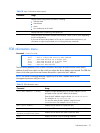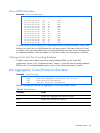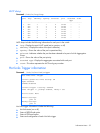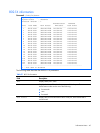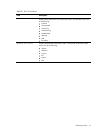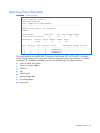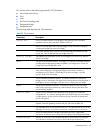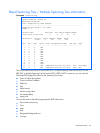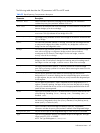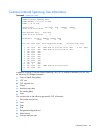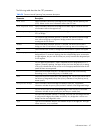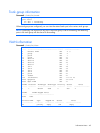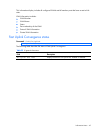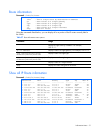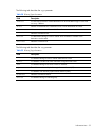
Information Menu 45
The following table describes the STP parameters in RSTP or MSTP mode.
Table 23
Rapid Spanning Tree parameter descriptions
Parameter Description
Current Root
Shows information about the root bridge for the Spanning Tree. Information
includes the priority (hex) and MAC address of the root.
Path-Cost
Path-cost is the total path cost to the root bridge. It is the summation of the path cost
between bridges (up to the root bridge).
Port
The current root port refers to the port on the switch that receives data from the
current root. Zero (0) indicates the root bridge of the STP.
Priority (bridge)
The bridge priority parameter controls which bridge on the network will become the
STP root bridge.
Hello
The hello time parameter specifies, in seconds, how often the root bridge transmits
a configuration bridge protocol data unit (BPDU). Any bridge that is not the root
bridge uses the root bridge hello value.
MaxAge
The maximum age parameter specifies, in seconds, the maximum time the bridge
waits without receiving a configuration bridge protocol data unit before it
reconfigures the STP network. If the bridge is not the root bridge, it uses the
MaxAge value of the root bridge.
FwdDel
The forward delay parameter specifies, in seconds, the amount of time that a
bridge port has to wait before it changes from learning state to forwarding state. If
the bridge is not the root bridge, it uses the FwdDel value of the root bridge.
Aging
The aging time parameter specifies, in seconds, the amount of time the bridge
waits without receiving a packet from a station before removing the station from the
Forwarding Database.
Priority (port)
The port priority parameter helps determine which bridge port becomes the
designated port. In a network topology that has multiple bridge ports connected to
a single segment, the port with the lowest port priority becomes the designated port
for the segment.
Cost
The port path cost parameter is used to help determine the designated port for a
segment. Generally speaking, the faster the port, the lower the path cost. A setting
of zero (0) indicates that the cost will be set to the appropriate default after the link
speed has been auto-negotiated.
State
Shows the current state of the port. The State field in RSTP/MSTP mode can be one
of the following: Discarding (DISC), Learning (LRN), Forwarding (FWD), or
Disabled (DSB).
Role
Shows the current role of this port in the Spanning Tree. The port role can be one of
the following: Designated (DESG), Root (ROOT), Alternate (ALTN), Backup (BKUP),
Master (MAST), or Unknown (UNK).
Designated bridge
Shows information about the bridge connected to each port, if applicable.
Information includes the priority (hex) and MAC address of the Designated Bridge.
Designated port
The port ID of the port on the Designated Bridge to which this port is connected.
Type
Type of link connected to the port, and whether the port is an edge port. Link type
values are AUTO, P2P, or SHARED.
MSTP: The Type field appears in /info/cist.



